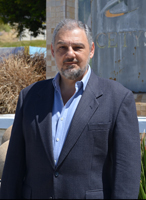The Renewable Energy Engineering Program began in 2015 due to the potential demand that is expected for these types of professionals and the opportunity for development (a growing trend) provided by Baja California, the California region in general (USA) and Baja California Sur (Mexico).
CETYS University Renewable Energy Engineering Program in Mexico
Dr. Isaac Azuzc | CETYS University
How important has renewable energy industry become to the Mexican economy/energy sector?
The legal and regulatory changes that have occurred in Mexico’s energy sector between 2008 and 2014 have made the electricity, gas and oil industries (historically, two state-run monopolies, PEMEX and CFE) more competitive. These structural changes and the country’s international commitment to actions aimed at mitigating climate change have opened up the possibility of developing and implementing renewable clean energy.
“Mexico’s pre-Reform energy pathway was not a sustainable one: the cumulative gains in GDP from the Reform to 2040 are estimated at more than $1 trillion, compared with a case in which the reforms do not take place.” (OECD/IEA, 2016)1
The General Law on Climate Change (LGCC, 2012, 2015) states that by 2024, 35% of the total energy generated must come from clean energy sources.
As part of a collaborative effort between energy sectors to coordinate actions promoting renewable energy, the 2014-2018 Special Program for the Use of Renewable Energies (PEAER) was published in 2014. It describes the actions that should guide the country towards compliance with the goals established by the Law for the Use of Renewable Energy and the Financing of Energy Transition (LAERFTE. 2008, 2013), legislation regarding the use of non-fossil fuels and clean energy.
In Mexico, in 2014, the primary energy demand was 188 million tons of equivalent oil (Mtoe), of which 83% corresponded to oil (51%) and natural gas (32%), the latter showing an increase in recent years (8% in 14 years). However, bioenergy (5%) and other renewable sources such as wind, geothermal, solar photovoltaic and hydropower only represented a marginal percentage of the total (4%). For example, of the approximately 300 TeraWatt-Hour (TWh) of electricity generated in 2014, only 50 TWh were generated by way of renewable energies, the largest source being hydroelectric plants (approximately 40TWh). This data shows how important renewable energy will be for Mexico’s energy and economic sectors for years to come.
What makes Baja California so especial for the development of renewable energy?
The geographical location of Baja California, its economic dynamics, industrial development, as well as its natural environmental conditions make it one of the most favorable places in Mexico for the development of renewable energy. Baja California has approximately 1,500km of coastline, which allows for a wide development of renewable energy related to the use of marine dynamics (waves, currents) and the potential for installation of wind farms. It also has the broadest tidal ranges in the country, the Gulf of California, opening up more potential for tidal energy. On the other hand, from the point of view of the use of photovoltaic solar energy, most of the state is located in areas of high irradiation. According to the Secretary of Energy’s National Inventory of Renewable Energies, this area has the potential to generate up to 5 million GWH per year.
What companies related to renewable energy are located in Baja California?
Some of the companies that are located in Baja California are: Electrosolar, Zero.energyon, SunPower, Gecko Logic, Atlantis Solar Systems, The Greeb Gate, IEnova (Energía Costa Azul), among others. In addition, many of the projects in operation or on the verge of implementation include companies such as Gamesa, Sempra Energy, Iberdrola, InterGen and of course, the Federal Electricity Commission.
When did CETYS Renewable Energy engineering program begin? Why?
The Renewable Energy Engineering Program began in 2015 due to the potential demand that is expected for these types of professionals and the opportunity for development (a growing trend) provided by Baja California, the California region in general (USA) and Baja California Sur (Mexico).
Since this is an emerging industry, how does CETYS’ renewable energy engineering program deliver students the training that employers require?
Throughout its 55 years of existence, CETYS University has been characterized by having collaborative relationships with the region’s productive sectors. The links with employers and the constant review of the educational programs offered by academics and representatives of different companies, as well as the content of these programs give a competitive advantage to CETYS graduates. The expectation is that this will be the case for future graduates of the renewable energy programs.
Can you give us a quick rundown of the curriculum?
The curriculum is comprised of two years of basic engineering subjects and two more years where students learn about wind and solar energy, mainly photovoltaics. The program includes a mandatory international renewable energy experience abroad for all students (enrolling in at least one course abroad in a country that has strong development in renewable energies).
Has CETYS University established any alliances, both nationally and internationally, that will benefit Baja California and California’s future with renewables?
The partnerships fostered with universities and companies around the globe are something that distinguishes CETYS University. The international mobility of students and teachers is an established activity for the institution. In the medium term (5 years), these links will have positive results for graduates of the renewable energy program, as has been the case with other engineering careers offered by CETYS.
How does Baja California industry contribute to California’s renewable energy demands? What future opportunities of cross country collaboration in this area do you foresee?
The relationships with California’s energy industry have existed for years, from the generation of geothermal power in the Baja California region (2nd largest plant in the world) that is connected to California’s fault lines, California’s wind energy market and a large number of American plants that manufacture photovoltaic cells in the state.
How does the current trade environment in the US affect the future of the program?
The California-Baja California region is one of the most dynamic regions in the world (socially, economically and culturally). Regional demand for energy will continue to increase, as will the demand for implementation of renewable energy sources due to the high potential for use. It is a clear need at the regional level (energy) and therefore in the long-term (decades) it will have to be a very important topic of discussion and action in the field of trade regardless of shifting short-term conditions.
1 OECD/IEA, 2016. Mexico Energy Outlook. World Energy Outlook Special Report. Organization for Economic Cooperation and Development (OECD) and International Energy Agency, Paris, France, 125 pp.

Dr. Isaac Azuz-Adeath
Professor/full-time researcher for the School of Engineering at the Center for Technical and Higher Education (CETYS), Ensenada Campus and Coordinator of the Master’s Degree program in Environment and Sustainable Development (CETYS System). He has received the CETYS Award for Educational Excellence in Research in 2012, 2013, 2015 and 2016 and is a member of the National System of Researchers (2013-2016)
The content & opinions in this article are the author’s and do not necessarily represent the views of AltEnergyMag
Comments (0)
This post does not have any comments. Be the first to leave a comment below.
Featured Product

